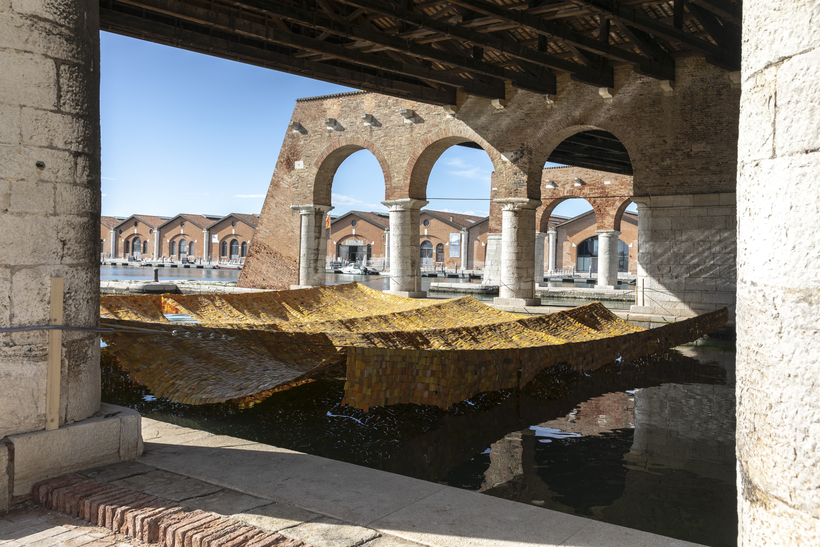On a bone-chilling afternoon last February, a heavily-layered group of 100 or so huddled on top of the snow-coated Eggli mountain in Switzerland’s glitzy ski town Gstaad. Gliding down the steep slope wasn’t anyone’s intention. They were there to watch the artist Serge Attukwei Clottey perform Lost and Found. On a wooden platform that held a pathway made of yellow plastic, body silhouettes cut out of that plastic, Clottey approached a pile of seven suitcases, knocked it down, and tossed the luggage along the path. Then he took a bow. Miniature bonfires, a little Greek chorus, burned in the background.
Clottey was among a group of artists invited to perform in different parts of Gstaad for the annual art festival Elevation 1049, and the towering peak was a conceptual fit for the Ghanaian mixed-media artist. His practice is informed by a reach for new heights, and an acquiescence to drifts and advents.
The placid waters of the 16th-century shipyard Gaggiandre, in Venice, offer a warmer site for Clottey’s latest creation. As part of the 18th Venice Architecture Biennale, Clottey has installed Time and Chance, a massive horizontal “tapestry” stretched across a docking area. The work is made of small plastic squares cut from yellow jerrycans and stitched together with copper wires, a “fabric” that hovers like gold leaf over green water—the very water that carried goods-hauling ships centuries ago, during the establishment of La Serenissima’s marine power.
In the context of the world’s largest architecture show, building a roof-like yellow brick road a few inches above the water speaks of both drift and community. “Time and Chance is about demarcating a place where people don’t have properly documented ownership of their homes,” Clottey tells AIR MAIL. “Using cutouts from the same material for different works in Saudi Arabia, Palm Springs, and now in Venice builds a sense of mobility around geographies.”
“Time and Chance is about demarcating a place where people don’t have properly documented ownership of their homes.”
The 38-year-old artist started working with plastic gallons—also known as Kuofor jugs (named after Ghana’s former president)—to disrupt the convoluted relationship between the container and his community. In his hometown of Jamestown and in the capital city Accra, where he lives today, Clottey saw women carrying water or oil in these bulky, mostly yellow, containers. This makeshift and unsanitary solution to the country’s water shortage eventually prompted him to craft a form of art he calls “Afrogallonism”: works of tactile simplicity, scaled both small and large. Time and Chance is Clottey’s first such work made in a suspended form. The structure is loosely stretched between the muscular columns of a dock, a secluded location behind Arsenale’s soaring arches.
At his studio in Accra’s Labadi district, Clottey works with a team of young locals who help him cut the worn-out gallons into tile-like pieces and wire them together. The studio’s various rooms are piled with plastic squares waiting to be transformed into artworks. Destined for various parts of the globe, particularly to the West for lauded art affairs, Clottey reminds us, “Migration is a human right.”
“The Laboratory of the Future” is on at the Venice Architecture Biennale until November 26
Osman Can Yerebakan is a New York–based curator and writer
